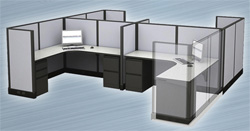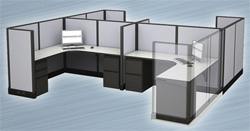
 Gone are the days when office real estate represented a sign of stature. According to Forbes, New York Mayor Michael Bloomberg sits in a bullpen with his staff. Zappos Chief executive Tony Hsieh has a cubicle much like his colleagues in their Las Vegas headquarters. And most recently President and CEO Meg Whitman inspired egalitarian culture back into the HP office by moving out of her office and into a cubicle.
Gone are the days when office real estate represented a sign of stature. According to Forbes, New York Mayor Michael Bloomberg sits in a bullpen with his staff. Zappos Chief executive Tony Hsieh has a cubicle much like his colleagues in their Las Vegas headquarters. And most recently President and CEO Meg Whitman inspired egalitarian culture back into the HP office by moving out of her office and into a cubicle.
Taking away walls and high cubicles can improve corporate culture, morale and productivity, while also reducing the costs and environmental impacts associated with an oversized real estate footprint. According to a survey on the Influence of Workplace Design and Practices, companies that employ open office layouts have observed increases in employee engagement and retention and decreases in employee misconduct.
At Westfield, Sr. EVP of U.S. Human Resources and Global Head of Management Stan Duncan had similar success transitioning to open workspace plan in Australia and the UK. Westfield is currently moving to a new office space in Los Angeles and is engaging employees to help design the space. From Westfield experience, Stan Duncan has a couple tips to share if you’re interested in transitioning your office or currently work in an open workspace.
First, take the time to understand your employee’s needs. Conduct a survey or 1-1 interviews to find out their working style, current level of satisfaction and willingness to move to a more open environment. If you feel confident your office is a good candidate, the next step is to engage employees. Let employees participate in the design process by receiving their input on desk designs, common areas and creative spaces. As you transition to your new office space, continue to solicit employee feedback with open communication methods.
If you’re on the receiving end of workplace transition, here are some tips to ease the change:
– For confidential conversations, take advantage of office conference rooms. Just because your office has transitioned into an open space doesn’t mean privacy is unattainable.
– Be respectful of your noise level. Keep conversations at your desk to a minimum and take longer conversations in common spaces.
– Take into account the heightened visibility and maintain professional, respectful behavior at all times.
– Collaborate! Open workspaces promote collaboration; use it as an opportunity to gain new insights from colleagues outside your department.
Leave a Reply